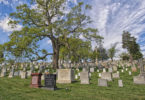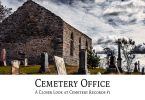Cemetery research is a basic part of genealogy research. Doing genealogy properly and thoroughly means cemetery research goes hand in hand with it. You will want to know where your ancestors are buried, not only so you can go there and pay your respects in person and see the area where your ancestor lived (since most people are buried close to their usual place of residence), but because of all of the additional genealogy information you can get from this type of research. Cemetery research is about more than just finding where your ancestors are buried. It can also reveal a lot of previously unknown information on your ancestor and his or her family. Here's how to get started in cemetery research and get the most possible information out of it.
How to Find the Cemetery Where Your Ancestor is Buried
The first step in doing cemetery research is locating the cemetery where your ancestor was buried. If you don't already know (or don't know a relative who knows), there are a number of ways to find out. Among the best methods for discovering the cemetery in question are:
Most death certificates include the name of the cemetery in which the person was buried, if the person was, in fact, buried (there are exceptions, such as cremation or burial at sea or if there was no body recovered to bury). This information is usually located at the very bottom of a death certificate, where it states what was done with the body (aka “disposal”). If the person was buried, the name of the cemetery is usually recorded near the “disposal” section. Since the death certificate also tells you the city, county, and state of death, you can look up the name of the cemetery online using this information and get its location so you can make an in-person visit if you choose to do so (and you should).
If you don't have a copy of the death certificate or don't know how to get one, obituaries often tell you where a person was buried. This information can be found in obituaries going back into the mid-19th century, and sometimes earlier. It isn't always there, but it's exciting when it is. Go online to one of the many websites that have searchable old newspapers and start looking for your ancestor's obituary (if you have even the most general idea of the date and location of death for your ancestor).
Websites With Lists of County Cemeteries and the People Buried in Them:
There are plenty of independent genealogy websites that have records of burials in local cemeteries. The U.S. GenWeb project is the best-known of these, but there are lots of others. A Google search may help you find your ancestor's final resting place.
FindAGrave.com:
This is the most famous cemetery website online. It has over 100 million burials listed across the United States and the world. Some of them even include photos and obituaries. This website is updated and maintained by volunteers who upload new burial information as a courtesy to others. Go there and use the search feature to find your ancestor. If he or she is not on the site, you can contact a volunteer who researches cemeteries in the area where your ancestor lived, and request that they do a lookup for you and post it on the site.
What to Do if the Grave is Not Marked
If you've found the cemetery, but discover the grave is not marked, that can be disappointing. You want a photo of a headstone for your family history records. At the very least, you want to know where the grave is located, so you can pay your respects (and maybe put a marker up there yourself, if you feel strongly about it… lots of genealogists do this).
If the grave isn't marked, all is not lost. You can still potentially discover the location of the grave. The easiest way is if the cemetery has an office. Not all of them do, but if the one you're exploring does, you can go to the office and request a map of burials. The office will have information on all burials there and where they are located, even the unmarked ones.
If there is no office, try going to the city hall. Ask around for the department that oversees the cemeteries. It is different in each city and town. Once you've found the appropriate department, ask if they have a map of burials in the cemetery. Many of them do. Other potential sources of finding the exact site of an unmarked burial include local historical societies and historians, and books of burials in a certain cemetery.
If you can't find any information, such as for a very ancient cemetery, you can often make a good guess as to where an unmarked ancestor is buried based on the headstones of other family members who are buried there. There is a good chance your ancestor is buried near them.
In very old cemeteries, you can often even see the outline of unmarked graves, because the coffins under the ground disintegrate over the years (wooden ones, especially), and cause the ground above to fall in over them, creating depressions in the ground that indicate the spot of a burial. There's a good chance that depression in the ground is where your ancestor is buried, especially if it is near that ancestor's relatives.
Knowing the final resting place of an ancestor puts a concluding page to their life in your family history. You know where they are and who is buried around them, which gives you an idea of their family relationships and their life in general. If they are buried in the town in which they lived and you visit that place, you can get an idea of how they lived and what life was like for them. You'll also be in a place where you can access local historical records to find out things about them you may never have otherwise known. Start researching the cemetery records of your ancestors today. You'll be surprised how rewarding it is, and how much new information you discover as you go.




